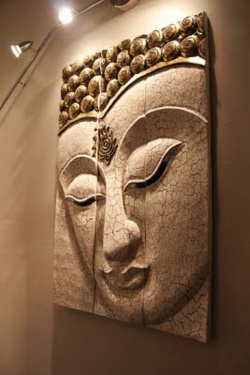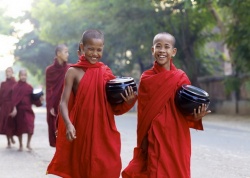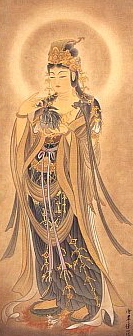Dzogchen & Zhentong
by Michael R. Sheehy on Thu, 2008-05-29 04:42
Reading through the miscellaneous guidance texts (khrid yig) of Khenpo Lodrö Drakpa, I came across a brief instruction that he gave on clarifying the distinctions between the 4 predominant Mahāyāna and Vajrayāna views:
(1) zhentong,
(2) rangtong,
(3) mahāmudrā, and
(4) dzogchen.[1]
Of particular interest to me is the question, "What are the differences between the zhentong and dzogchen views?" This is a question of recurring interest in learned Buddhist circles.
Not only have several friends in New York and elsewhere asked me this question, but I remember that while living in the monastery, monks would occasionally come to see my Tibetan teacher and ask him this very same question.
Rinpoche would smile and assure the monks by saying, "There are slight differences."
Since Khenpo Lodrak makes such clear distinctions between these 4 views ― and since his instructions are so short and sweet, I thought to translate the excerpt here,
The view of our own (zhentong) tradition is that within the natural lucid radiance of one’s own mind, there are coarse and subtle agitations, and there is a gross mentality that fabricates subtle and coarse degrees of laxity; within the nature of one’s own mind, there is an enduring experience of steadiness and stable attention, and there is an infinitely subtle mentality that fabricates these.
The only unmodified natural flow of freedom is that pristine awareness that is the natural manifestation of abiding clear light without fixations, without conceptualizations, and without preset references.
For the unfortunate, and from the vantage point of those who are less adept, this is difficult to fathom because it lies beyond the domain of what can be expressed through relative thoughts and words.[2]
The rangtong view is that nondual pristine awareness is free from all fixations onto any aspect of what persists as real.[3]
The mahāmudrā view is that vivid pristine awareness is the mere unmodified cognizance that quells the infinite proliferations of the subject-object complex.[4]
The dzogchen view is that the fabrications of the mind are qualitatively natural manifestations of pristine awareness that are originally pure clear light.
This is the awareness of the uncorrupted expanse, the wisdom-mind of the actuality of phenomena that remains a forever unchanging timeless ground as the radiance of nondual awareness;
the magnificent all-pervasive vast openness that is genuine and free from original time, spontaneously arising pristine awareness.[5]
These instructions were given on an occasion when Khenpo Lodrak was making general remarks on the 6-fold vajrayoga practices of the Kālachakra, and was distinguishing these various views in order to highlight how reality is regarded from multiple perspectives.[6]
Of course the danger with such concise comments is that its so easy to essentialize these nuanced and profound understandings of the nature of reality. Aware of that danger, and not seeking to de-complexify these views, its important to note the operative term that Khenpo Lodrak keeps chiming in on: "pristine awareness" (jñāna, ye shes).
In fact, this short piece falls into the subgenre of Tibetan contemplative literature that is concerned with making distinctions (shan 'byed) about such key terms and concepts.[7]
Similar distinctions have been a favorite topic of discussion in Jonang literature from the time of Dolpopa, and are considered to be very useful for enhancing one's own understanding of this material and therefore one's own meditative experiences.
Endnotes:
1. Ngag dbang Blo gros grags pa. Khrid yig tshogs, ca, 353-4. In Blo gros grags pa’i Gsung ‘bum, 'Dzam thang.
2. Here it reads, "rang lugs kyi lta ba ni / rang sems gsal ba'i rang mdangs la 'phro rgod phra rags bying ba phra rags ki blos byas rags pa rnams dang rang sems kyi ngo bo la gtad pa myong ba gnas pa la ched du rtsol ba la sogs pa'i blos byas phra ba mtha' dag dang bral ba'i ma bcos rang babs kho nar gnas pa'i 'od gsal rang byung mi rtog pa'i 'dzin med gtad med kyi ye shes 'di ga skal dman bla chung dag gi yid ngor shong dka' zhing kun rdzob sgra rtog gis brjod byas yul las 'das pa zhig yin ni re."
3. Here it reads, "rang stong pa'i lta ba ni / bden pa tshugs thub kyi rnam par 'dzin pa kun dang bral ba'i gnyis med kyi ye shes zhig yin."
4. Here it reads, "phyag chen pa'i lta ba ni / gzung 'dzin gyi spros ba mtha' dag nyer par zhi ba'i ma bcos rig tsam sa le ba'i ye shes zhig yin."
5. Here it reads, "rdzogs chen pa'i lta ba ni / 'od gsal ka dag rang byung gi ye shes yid byed mtshan mas ma slad pa'i dbyings rig gnyis med kyi rig gdangs nam yang mi 'gyur ba'i ye gzhi chos nyid kyi dgongs pa khyab brdal g(k?)long yangs chen po ye grol gnyug ma lhan cig skyes pa'i ye shes zhig yin."
6. The concluding line reads, "zhes pa'ang sbyor drug spyi don du rang gzhan gyi lta ba'i shan 'byed skabs lugs srol so so'i lta ba'i min tsam ma ti ki+rti'i nye bar bkod pa'o."
7. For further discussion, see Sheehy, Michael R. "Rangjung Dorje's Variegations of Mind: Ordinary Awareness and Pristine Awareness in Tibetan Buddhist Literature." In Buddhist Thought and Applied Psychological Research: Transcending the Boundaries. Routeledge Curzon Press, London, 2005.



